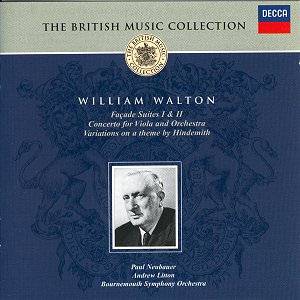It seems that Decca has had these performances on the
shelf since March 1996 when the recordings were made in The Guildhall,
Southampton, only now to issue them in their uniform liveried British
Music Collection. Given their general excellence and the relative paucity
of good performances – or any performances – of the Hindemith Variations
and given that the fluently engaged traversal of the Viola Concerto
is so winning, it’s something of a little mystery why we have had to
wait so long.
The disc opens with Façade Suites I and II.
Litton encourages rude vigour from the brass in the Scotch Rhapsody
and judges to perfection the swirling strings in an acutely intelligent
Valse. Good balancing informs the Tango-Pasodoble and there’s no need
to overplay the Polka – and Litton doesn’t. Yes those Spanish Nights
aren’t as atmospheric in Southampton as they were in Kingsway Hall in
1950 for Constant Lambert – but then Lambert is pretty much sui generis
in this repertoire. Old Sir Faulk is nicely syncopated – distinctive
muted trumpet and hot dance band melodrama. I liked Litton’s way with
Façade as I did equally his performance of the Viola Concerto
with Paul Neubauer. There is a real sense of momentum to their performance
and in the opening movement a sure sense of direction is always present
within the lyrical introspection; the effect, as all the great performers
of this work know, is to enhance the work’s profile. Neubauer’s tone
is appositely lean – it’s not an opulent, heavily vibrated and luscious
sound, it’s more alto than plangent cello though quite flexible through
the compass. In the fast second movement there is some fleet and lithe
playing amid the brass blocks and string fillips. Litton brings out
the colour of the score – something not always appreciated – and his
soloist brings a sure touch to the work’s architectural considerations.
Litton is good at characterising each of the contrasting movements.
Together they make much of the contrastive orchestral material and its
playing with and against the solo line, as they do of the viola’s final
yearning introspection from 9’21 onwards. The Hindemith Variations begin
splendidly; after the Introduction the strings soar in the first variation
– note the precision of attack and articulation here – in a well-argued
and cogent traversal. Tempi are apposite; Litton is again forward-looking
when it comes to the score, integrating themes into the sweep of the
score. In the fifth variation, for example, there is an ominous tread
in the lower strings, expertly delineated, leading to some eloquent
playing and the variation’s end, a resolved struggle, is one that achieves
a kind of serenity. The sense of struggle and resolution is everywhere
noticeable in this performance; after the burnished seventh variation
the work ends, following a series of fugal entries, in a sense of achieved
tranquillity. In a performance of this kind the intellectual and musical
arguments coalesce – most impressive.
Jonathan Woolf
see also review by Terry
Barfoot
Intellectual and musical arguments coalesce – most impressive. … see
Full Review


